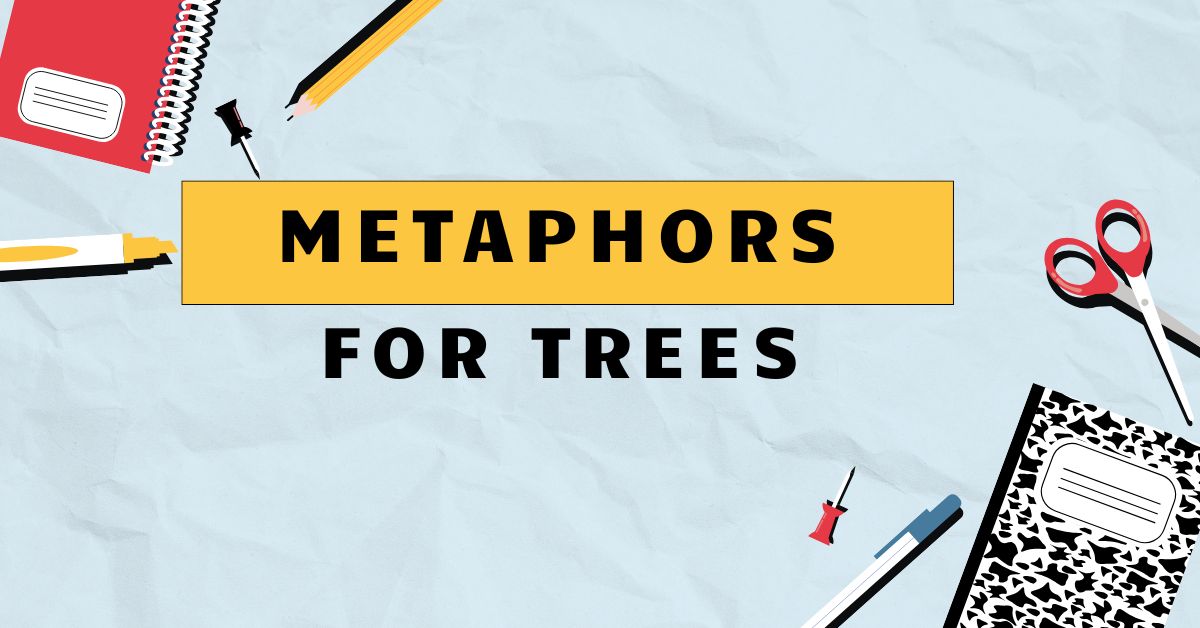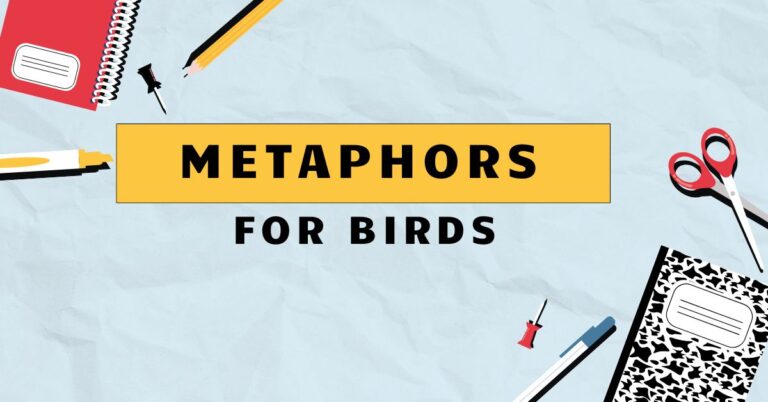34 Trees as Metaphors: Understanding Figurative Language
Metaphors are fundamental to how we understand the world, allowing us to draw connections between seemingly disparate concepts. Using trees as metaphors is particularly powerful, given their ubiquity in our environment and their rich symbolic associations.
This article explores the various ways trees are used metaphorically in English, enhancing your understanding of figurative language and improving your ability to interpret and use metaphors effectively. Whether you’re a student, writer, or language enthusiast, this guide will provide you with the knowledge and practice needed to master this fascinating aspect of English grammar and expression.
Table of Contents
- Introduction
- Definition of Metaphor
- Structural Breakdown of Tree Metaphors
- Types and Categories of Tree Metaphors
- Examples of Tree Metaphors
- Usage Rules for Tree Metaphors
- Common Mistakes with Tree Metaphors
- Practice Exercises
- Advanced Topics in Tree Metaphors
- Frequently Asked Questions
- Conclusion
Definition of Metaphor
Ametaphoris a figure of speech that directly compares two unrelated things, asserting that one thingisanother. Unlike similes, which use “like” or “as” to make a comparison, metaphors create a more forceful and direct connection.
This connection is based on shared characteristics or qualities between the two things being compared. Understanding metaphors is crucial for interpreting literature, poetry, and everyday language, as they add depth and layers of meaning to communication.
Metaphors are not meant to be taken literally; instead, they invite the reader or listener to consider the similarities and draw new insights.
In the context of using trees as metaphors, we leverage the inherent qualities and symbolic meanings associated with trees to describe or understand other concepts. Trees, with their roots, trunks, branches, leaves, and life cycle, offer a rich source of metaphorical imagery.
For example, a person described as having “deep roots” is being metaphorically compared to a tree, suggesting they have strong connections to their family, community, or values. The effectiveness of a metaphor lies in its ability to resonate with the audience and illuminate the subject in a new light.
Structural Breakdown of Tree Metaphors
The structure of a tree metaphor typically involves two main components: thetenorand thevehicle. The tenor is the subject to which metaphorical attributes are ascribed, and the vehicle is the metaphorical term itself (in this case, a tree or its parts).
The connection between the tenor and the vehicle creates the metaphorical meaning.
Consider the statement, “Her family is a strong oak.” Here, “her family” is the tenor, and “a strong oak” is the vehicle. The metaphor suggests that the family possesses qualities associated with a strong oak tree, such as resilience, stability, and longevity.
The effectiveness of this metaphor lies in the shared understanding of what a strong oak symbolizes. Understanding this basic structure helps in both interpreting and creating effective tree metaphors.
Another structural aspect is theground, which refers to the shared characteristics or qualities between the tenor and the vehicle. In the example above, the ground includes strength, resilience, and stability.
Identifying the ground is essential for understanding the intended meaning of the metaphor. Without a clear ground, the metaphor may seem arbitrary or confusing.
The relationship between the tenor, vehicle, and ground forms the foundation of a well-constructed tree metaphor.
Types and Categories of Tree Metaphors
Tree metaphors can be categorized based on the specific qualities of trees they emphasize. Here are some common categories:
Growth and Development Metaphors
These metaphors focus on the growth cycle of a tree, from a small seed to a mature plant. They are often used to describe personal or professional development, learning, or the evolution of ideas.
Strength and Resilience Metaphors
These metaphors highlight the tree’s ability to withstand storms, droughts, and other challenges. They are used to describe people or organizations that demonstrate fortitude and perseverance.
Family and Lineage Metaphors
Trees, especially family trees, are often used to represent ancestry, heritage, and the interconnectedness of family members. These metaphors emphasize roots, branches, and the passing down of traditions.
Stability and Groundedness Metaphors
These metaphors focus on the tree’s deep roots and its ability to remain firmly planted in the ground. They are used to describe people who are reliable, dependable, and connected to their values.
Shelter and Protection Metaphors
Trees provide shelter and protection to animals and other plants. These metaphors are used to describe people or organizations that offer safety, security, and support.
Aging and Wisdom Metaphors
Old trees, with their rings and weathered bark, are often seen as symbols of wisdom and experience. These metaphors are used to describe individuals who have gained knowledge and insight over time.
Interconnectedness Metaphors
Trees in a forest are interconnected through their root systems and the ecosystem they create. These metaphors highlight the importance of community, collaboration, and interdependence.
Examples of Tree Metaphors
Below are examples of tree metaphors, categorized by the types discussed above. Each category includes a table with multiple examples to illustrate the different ways trees can be used metaphorically.
Growth and Development Examples
These examples illustrate how trees are used to represent stages of growth, learning, and personal evolution. Each example emphasizes the process of becoming, from a small beginning to a mature state.
The table below provides specific examples of growth and development metaphors using trees:
| Metaphor | Explanation |
|---|---|
| “He’s just a sapling in the business world.” | Compares someone new to the business world to a young tree, implying inexperience and potential for growth. |
| “Her career began as a small seed.” | Represents the humble beginnings of a career, suggesting it started small but has the potential to grow. |
| “The idea blossomed like a flowering tree.” | Describes the flourishing of an idea, comparing it to a tree bursting into bloom. |
| “His knowledge has grown like the rings of a tree.” | Indicates that his knowledge has accumulated over time, layer by layer, similar to the growth rings of a tree. |
| “She’s branching out into new fields of study.” | Compares her exploration of new subjects to a tree extending its branches. |
| “The company’s roots are still shallow.” | Implies that the company is not yet well-established or secure. |
| “He’s still trying to put down roots in the new city.” | Suggests he is in the process of establishing himself and becoming comfortable in a new place. |
| “Her potential is a young tree waiting to be nurtured.” | Highlights the untapped potential that needs care and attention to develop fully. |
| “His skills are like sap rising in the spring.” | Indicates a renewed and vigorous growth of his abilities. |
| “The project is bearing fruit after years of labor.” | Compares the successful outcome of the project to a tree producing fruit. |
| “The organization is growing like a forest, expanding its reach.” | Depicts rapid and extensive growth, similar to the spread of a forest. |
| “His influence has spread like the roots of an old tree.” | Describes the extensive and far-reaching impact of his influence. |
| “She’s cultivating her talents like a gardener tends to a tree.” | Highlights the careful and deliberate effort she is putting into developing her abilities. |
| “The business is budding with new opportunities.” | Compares the emergence of new opportunities to the budding of a tree in spring. |
| “He needed to prune some bad habits to grow professionally.” | Suggests that he needed to eliminate negative behaviors to advance in his career. |
| “The lessons he learned were the seeds of his future success.” | Indicates that his learning experiences were the foundation for his future achievements. |
| “Her confidence grew like a tree reaching for the sky.” | Depicts her increasing confidence and ambition. |
| “The community garden is a testament to their collective growth.” | Represents the shared progress and development of the community. |
| “He’s nurturing his team like a forester cares for his trees.” | Highlights his supportive and attentive approach to managing his team. |
| “Her ideas took root and flourished.” | Suggests her ideas became established and thrived. |
| “The startup began as a seedling in a competitive market.” | Indicates the startup’s weak beginnings and the challenging environment it faced. |
| “He’s watching his investments grow like trees in the spring.” | Shows the investments are growing rapidly and healthily. |
| “She’s allowing her creativity to branch out in new directions.” | Suggests she is exploring new and varied creative outlets. |
| “The project is bearing fruit after much hard work.” | Implies the project is finally yielding results and success. |
Strength and Resilience Examples
These metaphors use the strength and resilience of trees to describe people, organizations, or ideas that demonstrate fortitude and the ability to withstand challenges. The examples emphasize the enduring nature and unwavering presence of the subject.
The table below provides specific examples of strength and resilience metaphors using trees:
| Metaphor | Explanation |
|---|---|
| “He stood tall like an oak in the face of adversity.” | Compares his ability to withstand challenges to the strength and stability of an oak tree. |
| “Her spirit is as unyielding as a redwood.” | Highlights her unwavering determination and resilience. |
| “The company weathered the storm like a deeply rooted tree.” | Suggests that the company survived a difficult period due to its strong foundations. |
| “His faith is a sturdy tree that cannot be shaken.” | Indicates that his faith is strong and unwavering. |
| “She’s a resilient willow, bending but never breaking.” | Compares her ability to adapt and recover from setbacks to the flexibility of a willow tree. |
| “The old building stood like a sentinel tree, watching over the town.” | Highlights the building’s enduring presence and protective role. |
| “His principles are as solid as the trunk of a tree.” | Suggests that his principles are firm, unwavering, and provide a strong foundation for his actions. |
| “She faced the challenge with the strength of a mighty tree.” | Depicts her handling of the challenge with great power and resilience. |
| “The organization is a strong tree providing shelter to its members.” | Highlights the organization’s role in providing support and security. |
| “His determination is a hard wood that can withstand any pressure.” | Compares his unwavering resolve to a strong, durable wood. |
| “The community is rooted in resilience, like a forest after a fire.” | Suggests that the community has the ability to recover and thrive even after facing significant challenges. |
| “Her resolve is a steadfast tree in a hurricane.” | Highlights her unwavering determination in the face of extreme adversity. |
| “The team’s bond is as strong as the interwoven roots of trees.” | Compares the strong connection within the team to the interconnected root systems of trees. |
| “His spirit is a sturdy trunk, unyielding to the winds of change.” | Depicts his resilience and resistance to external pressures. |
| “She is a towering pine, standing strong against the harsh winds.” | Compares her strength and resilience to the enduring nature of a tall pine tree. |
| “The old bridge stood like a gnarled oak, a testament to its durability.” | Highlights the bridge’s long-lasting strength and resilience. |
| “His courage is like the deep roots of a tree, anchoring him in difficult times.” | Indicates that his courage provides stability and strength during challenging moments. |
| “The family’s bond is a strong tree, weathering life’s storms together.” | Compares the family’s unity and resilience to a tree that withstands harsh weather. |
| “She faced the criticism with the unshakeable strength of an ancient tree.” | Depicts her handling of the criticism with great fortitude and composure. |
| “The city has the resilience of a forest, always regenerating after setbacks.” | Suggests that the city has a strong capacity to recover and rebuild after facing difficulties. |
| “His determination is a solid tree, unyielding to any obstacle.” | Compares his unwavering resolve to a strong, durable tree. |
| “She remained as firm as an rooted tree, despite the chaos around her.” | Highlights her stability and resistance to external pressures. |
| “The team’s unity is a sturdy tree, providing support in every season.” | Depicts the team’s strong bond and mutual support in all circumstances. |
| “His spirit is a robust tree that cannot be easily felled.” | Indicates his strong and resilient character. |
Family and Lineage Examples
These metaphors use the imagery of family trees to represent ancestry, heritage, and the interconnectedness of family members. The examples emphasize the roots, branches, and the continuity of traditions across generations.
The table below provides specific examples of family and lineage metaphors using trees:
| Metaphor | Explanation |
|---|---|
| “The family tree has deep roots in this community.” | Indicates that the family has a long history and strong ties to the community. |
| “She is a branch of a very old family tree.” | Identifies her as a descendant of a long-established family. |
| “Their family history is a sprawling oak, with many branches.” | Compares the extensive and diverse history of the family to a large oak tree with numerous branches. |
| “He is the root of a new generation.” | Suggests that he is the ancestor from whom a new line of descendants will originate. |
| “The family’s values are the sap that flows through the tree.” | Compares the family’s core beliefs and traditions to the essential life force that sustains the family. |
| “She is a new shoot on the family tree, full of potential.” | Highlights her as a promising and burgeoning member of the family. |
| “The family’s legacy is a towering redwood, standing the test of time.” | Depicts the family’s enduring impact and historical significance. |
| “He is the trunk of the family, providing stability and support.” | Compares his role to the central, supportive figure in the family. |
| “The family’s traditions are the rings of the tree, marking each year.” | Indicates that the family’s customs and practices represent the passage of time and the family’s history. |
| “She is a strong branch, carrying the family name with pride.” | Highlights her as a respected and honorable member of the family. |
| “The family’s roots are intertwined, showing their deep connection.” | Suggests that the family members are closely bonded and deeply connected to each other. |
| “He is a sturdy limb on the family tree, offering strength and support.” | Compares his role to a strong and reliable member of the family. |
| “The family’s story is a forest of interconnected trees.” | Depicts the complex and interwoven narratives of the family members. |
| “She is a blossoming flower on the family tree, bringing joy and beauty.” | Highlights her as a source of happiness and positivity within the family. |
| “The family’s heritage is a rich tapestry woven from the threads of each branch.” | Compares the family’s history to a complex and beautiful fabric created by the contributions of each family member. |
| “He is a steadfast guardian of the family tree, protecting its legacy.” | Depicts his role as a protector and preserver of the family’s history and traditions. |
| “The family’s spirit is a resilient evergreen, thriving through all seasons.” | Compares the family’s enduring spirit to a tree that remains vibrant and strong throughout the year. |
| “She is a vibrant leaf on the family tree, adding color and life.” | Highlights her as a dynamic and lively member of the family. |
| “He is a dependable bough on the family tree, always there to lend support.” | Compares his role to a supportive and reliable member of the family. |
| “The family’s love is a nurturing rain, helping each branch to flourish.” | Suggests that the family’s love and support enable each member to thrive and succeed. |
| “She is a promising seedling on the family tree, ready to grow and contribute.” | Highlights her as a young and promising member of the family. |
| “He is a wise old tree, the family historian, full of knowledge and stories.” | Compares his role to a knowledgeable and experienced member of the family. |
| “The family’s journey is a winding path through a dense forest of history.” | Depicts the family’s complex and eventful past. |
| “She is a bright bloom on the family tree, bringing joy and beauty to all.” | Highlights her as a source of happiness and positivity within the family. |
Stability and Groundedness Examples
These metaphors use the deep roots and firm presence of trees to represent stability, reliability, and a strong connection to one’s values or environment. The examples emphasize the unwavering nature and dependable character of the subject.
| Metaphor | Explanation |
|---|---|
| “He is as grounded as an ancient oak.” | Compares his stability and reliability to the deep roots of an old tree. |
| “Her values are deeply rooted.” | Suggests that her principles are firm and unwavering. |
| “The organization provides a stable foundation like the trunk of a tree.” | Highlights the organization’s role in providing security and support. |
| “His presence is a steadying force, like a tree in a storm.” | Indicates that his presence brings calm and stability in difficult situations. |
| “She is rooted in her community.” | Suggests that she has strong ties and a deep connection to her local area. |
| “His beliefs are a firm foundation, like the roots of a tree.” | Compares his convictions to the strong, supporting roots of a tree. |
| “The company’s ethics are the solid ground it stands on.” | Highlights the importance of ethical practices in maintaining the company’s stability. |
| “She is a steadfast presence, like a tree in the landscape.” | Depicts her as a constant and reliable figure. |
| “His integrity is like the unyielding trunk of a tree.” | Compares his honesty and moral principles to the strong, upright trunk of a tree. |
| “The family’s bond is their anchor, like deep roots in the earth.” | Suggests that the family’s connection provides stability and security. |
| “He is a reliable support, like a sturdy branch of a tree.” | Compares his role to a strong and dependable member of the team. |
| “Her principles are her bedrock, unshakeable like a tree’s roots.” | Highlights her unwavering adherence to her values. |
| “The community’s unity is its strength, like a forest of interconnected trees.” | Suggests that the community’s solidarity provides resilience and support. |
| “He is a constant presence, like a landmark tree in the neighborhood.” | Depicts him as a familiar and dependable figure. |
| “Her wisdom is deeply rooted, providing guidance and insight.” | Compares her knowledge and understanding to the profound roots of a tree. |
| “He is a reliable friend, like a sturdy tree you can always lean on.” | Suggests that he is a dependable and supportive companion. |
| “Her values are the sturdy trunk that supports her actions.” | Highlights the importance of her principles in guiding her behavior. |
| “He is a firm presence, like a tree that stands tall in any weather.” | Depicts him as a resilient and steadfast figure. |
| “Her integrity is the solid foundation upon which she builds her life.” | Compares her honesty and moral principles to a strong, supporting base. |
| “He is a dependable guide, like a familiar tree marking the path.” | Suggests that he provides clear and reliable direction. |
| “Her principles are as unshakable as the roots of an oak.” | Highlights her unwavering adherence to her values. |
| “He stands firm like a tree, regardless of the storms around him.” | Indicates his stability and resilience in the face of adversity. |
| “Her commitment is like the deep roots that keep the tree standing.” | Compares her dedication to the essential roots that maintain a tree’s stability. |
| “He is a safe harbor, like a tree offering shelter from the storm.” | Suggests that he provides protection and security in times of trouble. |
Shelter and Protection Examples
These metaphors use the sheltering qualities of trees to represent people, organizations, or ideas that offer safety, security, and support. The examples emphasize the protective and nurturing aspects of the subject.
| Metaphor | Explanation |
|---|---|
| “The organization is a sheltering tree for those in need.” | Compares the organization to a tree that provides protection and support to vulnerable individuals. |
| “She is a protective presence, like a tree guarding its saplings.” | Highlights her role in safeguarding and nurturing those under her care. |
| “His guidance is like the shade of a tree on a hot day.” | Suggests that his advice and support provide comfort and relief. |
| “The community center is a safe haven, like a tree offering shelter from the storm.” | Compares the center to a tree that provides protection and security during difficult times. |
| “She is a nurturing influence, like a tree providing sustenance to its surroundings.” | Highlights her role in supporting and nourishing those around her. |
| “His support is like a sturdy branch, offering a safe place to rest.” | Compares his assistance to a strong and reliable support that provides comfort and security. |
| “The family is a protective canopy, shielding its members from harm.” | Suggests that the family provides a safe and secure environment for its members. |
| “She is a watchful guardian, like a tree standing sentinel over the forest.” | Highlights her role in protecting and overseeing those under her care. |
| “His friendship is like a sheltering tree, providing comfort and security.” | Compares his companionship to a tree that offers protection and support. |
| “The school is a nurturing environment, like a forest fostering young growth.” | Suggests that the school provides a supportive and enriching environment for its students. |
| “She is a source of comfort, like a tree offering shade on a sunny day.” | Highlights her role in providing relief and solace. |
| “His advice is like the wisdom of an old tree, guiding you safely through the woods.” | Compares his guidance to the knowledge and experience of an old tree. |
| “The hospital is a sanctuary, like a tree offering refuge from the storm.” | Suggests that the hospital provides a safe and secure place for healing and recovery. |
| “She is a protective force, like a tree shielding its roots from erosion.” | Highlights her role in safeguarding and preserving those under her care. |
| “His presence is like a comforting tree, providing a sense of peace and security.” | Compares his presence to a tree that offers tranquility and reassurance. |
| “The library is a haven of knowledge, like a forest rich with resources.” | Suggests that the library provides a wealth of information and learning opportunities. |
| “She is a nurturing influence, like a tree providing life-giving sustenance.” | Highlights her role in supporting and nourishing those around her. |
| “His guidance is like a well-marked trail, leading you safely through the forest.” | Compares his advice to a clear and reliable path that ensures safe passage. |
| “The museum is a treasure trove, like a forest filled with wonders.” | Suggests that the museum offers a wealth of cultural and historical artifacts. |
| “She is a reliable protector, like a tree standing guard over its domain.” | Highlights her role in safeguarding and defending those under her care. |
| “His support is like a strong root system, providing stability and nourishment.” | Compares his assistance to the essential roots that maintain a tree’s stability and health. |
| “The shelter is a safe haven, like a forest offering refuge from danger.” | Suggests that the shelter provides protection and security for those in need. |
| “She is a comforting presence, like a tree providing shade and solace.” | Highlights her role in offering relief and reassurance. |
Usage Rules for Tree Metaphors
Using tree metaphors effectively requires understanding certain guidelines. First, ensure the comparison is logical and resonates with the audience.
The shared qualities between the tree and the subject should be clear and relevant. Avoid forced or obscure comparisons that may confuse the reader.
Second, maintain consistency in your metaphorical language. Mixing metaphors can create a jarring effect and undermine the intended meaning.
Third, consider the context and tone of your writing. Tree metaphors can add depth and beauty to your prose, but they should be used judiciously and appropriately.
Another important rule is to be mindful of cultural associations. Different cultures may have different symbolic meanings for trees.
For example, in some cultures, the oak tree represents strength and longevity, while in others, it may have different connotations. Be aware of these nuances and choose your metaphors accordingly.
Also, ensure your metaphors are original and avoid clichés. Overused tree metaphors can lose their impact and make your writing seem uninspired.
Strive to create fresh and imaginative comparisons that capture the reader’s attention.
Finally, remember that a good metaphor should enhance understanding, not obscure it. If your metaphor requires extensive explanation or feels forced, it may be better to choose a different figure of speech.
The best tree metaphors are those that feel natural and intuitive, adding depth and richness to your writing without drawing undue attention to themselves.
Common Mistakes with Tree Metaphors
One common mistake is using mixed metaphors, where two or more incompatible metaphors are combined, leading to confusion. Incorrect: “He’s a sapling in the business world, navigating the sea of opportunities.” (Mixing the growth metaphor of a “sapling” with the nautical metaphor of a “sea”). Correct: “He’s a sapling in the business world, still learning to grow.”
Another mistake is using clichés. Overused metaphors like “strong as an oak” lack originality and impact. Incorrect: “He is as strong as an oak.” Correct: “He stood resilient, like an ancient redwood weathered by countless storms.” Using more specific and vivid language creates a stronger image.
Inappropriate context is another pitfall. Using a tree metaphor in a setting where it doesn’t fit can be jarring. Incorrect: “The computer code branched out like a tree.” Correct: “The computer code expanded with modular components, like branches extending from a central trunk.” The revised version provides a more suitable comparison.
| Mistake | Incorrect Example | Correct Example |
|---|---|---|
| Mixed Metaphor | “The project is a seedling sailing in uncharted waters.” | “The project is a seedling that needs careful nurturing.” |
| Cliché | “She is as wise as an old tree.” | “Her wisdom is like the deep roots of an ancient tree, providing stability and insight.” |
| Inappropriate Context | “The algorithm grew like a tree.” | “The algorithm expanded with each new function, like branches on a tree.” |
| Lack of Clarity | “His mind is a tree.” | “His mind is a fertile forest, full of ideas and possibilities.” |
Practice Exercises
Test your understanding of tree metaphors with these exercises. Identify the type of metaphor used in each sentence and explain its meaning.
Exercise 1: Identify the type of tree metaphor and explain its meaning.
| Question | Answer |
|---|---|
| 1. “Her career began as a small seed, now it’s a flourishing forest.” | Growth and Development. Meaning: Her career started small but has grown into something substantial. |
| 2. “He stood tall like an oak, weathering every storm.” | Strength and Resilience. Meaning: He remained strong and steadfast despite facing challenges. |
| 3. “The family tree has deep
roots in this town, generations have lived here.” |
Family and Lineage. Meaning: The family has a long history and strong ties to the community. |
| 4. “She is as grounded as an ancient oak, never swayed by trends.” | Stability and Groundedness. Meaning: She is reliable and stays true to her values. |
| 5. “The organization is a sheltering tree, providing support to those in need.” | Shelter and Protection. Meaning: The organization offers safety and assistance to vulnerable individuals. |
Exercise 2: Rewrite the following sentences using a tree metaphor.
- Original: “His knowledge increased over time.”
- Answer: “His knowledge grew like the rings of a tree, each year adding depth and understanding.”
- Original: “She remained strong despite the challenges.”
- Answer: “She stood resilient, like a deeply rooted tree weathering the strongest storms.”
- Original: “The family has a long history in the region.”
- Answer: “The family tree has deep roots in the region, its branches spreading across generations.”
- Original: “He is a reliable and trustworthy person.”
- Answer: “He is as grounded as an ancient oak, a steadfast presence in our lives.”
- Original: “The charity provides assistance to those in need.”
- Answer: “The charity is a sheltering tree, offering support and protection to vulnerable members of the community.”
Exercise 3: Correct the following sentences that contain mistakes in their use of tree metaphors.
- Original: “He’s a seedling in the business world, swimming in a sea of opportunities.”
- Corrected: “He’s a seedling in the business world, just beginning to sprout and grow.”
- Original: “She is as wise as a tree, navigating the turbulent waters of life.”
- Corrected: “Her wisdom is like the deep roots of an ancient tree, providing stability and insight in turbulent times.”
- Original: “The project is a tree that needs to set sail and find its roots.”
- Corrected: “The project is a sapling that needs nurturing to establish strong roots and grow.”
Advanced Topics in Tree Metaphors
Delving deeper into tree metaphors involves exploring their cultural significance, historical usage, and literary applications. In literature, tree metaphors often serve as powerful symbols, representing themes such as life, death, renewal, and the interconnectedness of all things.
Different types of trees may carry distinct symbolic meanings. For example, the willow is often associated with sorrow and mourning, while the oak symbolizes strength and endurance.
Understanding these cultural and symbolic nuances can enrich your interpretation and use of tree metaphors.
Another advanced topic is the use of extended tree metaphors, where the comparison is developed over several sentences or paragraphs. This technique allows for a more complex and nuanced exploration of the subject.
For example, a writer might compare a character’s emotional journey to the growth of a tree, tracing its progress from a fragile seedling to a resilient and mature plant. Extended metaphors can add depth and resonance to your writing, but they require careful planning and execution.
Additionally, consider the ethical implications of using tree metaphors. In environmental literature, trees are often used to represent the natural world and the importance of conservation.
Be mindful of the potential to romanticize or oversimplify complex environmental issues. Using tree metaphors responsibly involves acknowledging the ecological significance of trees and promoting awareness of the threats they face.
Frequently Asked Questions
What is the difference between a metaphor and a simile?
A metaphor directly equates two things (e.g., “He is an oak”), while a simile uses “like” or “as” to make a comparison (e.g., “He is as strong as an oak”). Metaphors are more forceful and create a stronger connection.
How can I avoid using clichés in my tree metaphors?
Use specific and vivid language, and focus on unique qualities of trees that are relevant to your subject. Instead of “strong as an oak,” try “resilient as a redwood weathered by countless storms.”
What are some common cultural associations with trees?
Different cultures associate different meanings with trees. For example, the oak often represents strength, the willow represents sorrow, and the olive tree represents peace.
How can I create an extended tree metaphor?
Develop the comparison over several sentences or paragraphs, exploring multiple aspects of the tree and its relationship to the subject. Maintain consistency and ensure the metaphor enhances understanding.
Why are tree metaphors so effective?
Trees are ubiquitous, deeply symbolic, and offer a rich source of imagery. Their qualities of growth, strength, stability, and interconnectedness resonate with many aspects of human experience.
Conclusion
Tree metaphors are a powerful tool for enriching your language and deepening your understanding of the world. By mastering the art of using tree metaphors, you can add depth, resonance, and beauty to your writing and communication.
Remember to use these metaphors thoughtfully and creatively, always striving for clarity, originality, and relevance. Whether you’re describing personal growth, family connections, or the strength of an organization, tree metaphors offer a rich source of inspiration and insight.
Embrace the opportunity to explore the many ways trees can illuminate our understanding of the world, and watch your language skills flourish.







